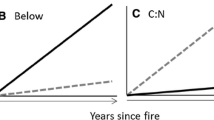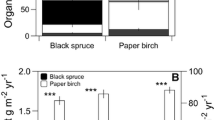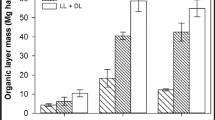Abstract
Effects of fire and site type on carbon (C) and nitrogen (N) balances were determined by following the change of total and component C and N pools along four chronosequences of fire-prone Siberian Scots pine ecosystems. These differed in the mean return interval of surface fires (unburned – moderately burned, 40 years – heavily burned, 25 years) and site quality (lichen versus Vaccinium site type). Of the Vaccinium site type (higher site quality) only a moderately burned chronosequence was studied. A total of 22 even-aged stands were investigated with stand ages ranging from 2 to 383 years. The C balance was dominated by the opposing dynamics of coarse woody debris (CWD) and biomass and could be divided into three phases: (1) Young stands (up to 40 years)acted as a net source for C of 6-10 mol C m-2 year-1 because the previous generation CWD pool originating from stand-replacing crown fires decayed much faster than biomass increased. During this period the C pool in the unburned lichen type chronosequence decreased from 807 to 480 mol C m-2. (2) Middle aged stands (40-100 years) being in a stage of maximum biomass accumulation were a net sink of 8-10 mol C m-2 year-1. (3)Maturestands (100 to > 350 years) continued to sequester C at a lower rate (0.8-2.5mol C m-2 year-1). Differences in the rates of C sequestration during the two later phases could be explained by the complex interaction between surface fire regime and site type. Recurrent surface fires resulted in enhanced mortality and regularly redistributed C from the living to the CWD pool thereby lowering the rate of C sequestration. Site quality determined the potential to recover from disturbance by fire events. Differences in site type did not correlate with soil and total ecosystem N pool size. However, the N status of needles as well as the N pool of physiologically active tissue was highest in the stands of the Vaccinium type. The “woody” C pool (biomass + CWD) was sensitive to differences in surface fire regime and site type. It was lowest in the heavily burned lichen type chronosequence (297 ± 108 mol C m-2), intermediate in the unburned and moderately burned lichen type chronosequence (571 ± 179 mol C m-2) and highest in the moderately burned Vaccinium type chronosequence (810 ± 334 mol C m-2). In contrast, the total soil C pool (organic plus mineral layer down to a depth of 25 cm) was independent of stand age, surface fire regimeand site type and fluctuated around a value of 250 mol C m-2. The organic layer C pool oscillated in response to recurring surface fires and its C pool was dependent on time since fire increasing at a rate of about 1.5 mol C m-2 year-during the first 40 years and then reaching a plateau of 170 mol C m-2. The total ecosystem N pool was 7.4 ± 1.5 mol N m-2 on average of which only 25 % were stored in biomass or coarse woody debris. Total ecosystem N was independent of stand age, surface fire regime and site type. No correlation was found between total ecosystem C and N pools. Average total ecosystem C:N ratio was 114 ± 35 mol C mol N-1. A conceptual model illustrating how changes in the regime of stand-replacing crown fires and recurrent surface fires and changes in site quality interact in determining the long-term C balance in Siberian Scots pine forests is presented.
Similar content being viewed by others
References
Apps M J and Kurz W A 1994 The role of Canadian forests in the global carbon budget. In Carbon balance of world+s forested ecosystems: towards a global assessment. Ed. M Kanninen. pp 14-39. Proceedings of the IPCC AFOS Workshop held in Joensuu. Painatuskeskus, Helsinki.
AG Boden 1994 Bodenkundliche Kartieranleitung. 4th edition. Schweizerbart'sche Verlagsbuchhandlung, Hannover, Germany, 392 p.
Bormann B T, Spaltenstein H, McClellan M H, Ugolini F C, Cromack J R and Nay S M 1995 Rapid soil development after windthrow disturbance in pristine forests. J. Ecol. 83, 747-757.
Cajander A K 1926 The theory of forest types. Acta For. Fenn. 29(3), 1-108.
Dixon RK and Krankina ON 1993 Forest fires in Russia: carbon dioxide emission to the atmosphere. Can. J. For. Res. 23, 700-705.
FIRESCAN Science Team 1996 Fire in ecosystems of boreal Eurasia: The Bor Forest Fire Experiment, Fire Research Campaign Asia-North (FIRESCAN). In Biomass Burning and Global Change. Vol. II. Ed. J S Levine. pp 848-873. MIT Press, Cambridge, MA.
Glebov F Z 1969 Bogs and Wetlands of the Forest Zone of the Yenisei Left-Bank [in Russian]. Nauka, Moscow. 132 p.
Gorbachev V N and Popova E P 1996 Fires and soil formation. In Fire in Ecosystems of Boreal Eurasia. Eds. J G Goldammer and V V Furyaev. pp 331-336, Kluwer Academic Publishers, Dordrecht.
Gower S T, McMurtie R E, and Murty D 1996 Above-ground net primary production decline with stand age: potential causes. Trends Ecol. Evol. 11, 378-382
Grogan P, Bruns T D, Chapin F S III 2000 Fire effects on ecosystem nitrogen cycling in a Californian Bishop Pine. Oecologia 122(4), 537-544
Gutsell S L and Johnson E A 1996 How fire scars are formed: coupling a disturbance process to its ecological effect. Can. J. For. Res. 26, 166-174.
Harden J W, Trumbore S E, Stocks B J, Hirsch A, Gower S T, O'Neill K P and Kasischke E S 2000 The role of fire in the boreal carbon budget. Global Change Biol. (in press)
Helmisaari H-S 1992 Nutrient retranslocation in three Pinus sylvestris stands. For. Ecol. Manage. 51, 347-367.
Helmisaari H-S 1995 Nutrient cycling in Pinus sylvestris stands in eastern Finland. Plant Soil 168169, 327-336.
Holland E A, Braswell B H, Lamarque J-F, Townsend A, Sulzman J, Müller J-F, Dentener F, Brasseur G, Levy II H, Penner J E and Roelofs G-J 1997 Variations in the predicted spatial distribution of atmospheric nitrogen deposition and their impact on carbon uptake by terrestrial ecosystems. J. Geophys. Res. 102 (D13), 15,849-15,866.
Holling C S, Peterson G, Marples P, Sendzimir J, Redford K, Gunderson L and Lambert D 1996 Self-organization in ecosystems: lumpy geometries, periodicities and morphologies In Global change and terrestrial ecosystems. Eds. B Walker and W Steffen. pp 346-384, Cambridge University Press, Cambridge.
Kolchugina T P and Vinson TS 1995 Role of Russian forests in global carbon balance. Ambio 24, 258-264.
Krankina ON and Harmon ME 1995 Dynamics of the dead wood carbon pool in Northwestern Russian boreal forest. Water Air Soil Pollut. 85, 227-238.
Krankina O N, Harmon ME, and Griazkin A V 1999 Nutrient stores and dynamics of woody detritus in a boreal forest: modeling potential implications at the stand level. Can. J. For. Res. 29, 20-32.
Kuhlbusch T A and Crutzen P J 1995 Toward a global estimate of black carbon in residues of vegetation fires representing a sink of atmospheric CO2 and a source of O2. Global Biogeochem. Cycles 9, 491-501.
Kuhlbusch T A, Lorbert J M, Crutzen P J and Warneck P 1991 Molecular nitrogen emissions from denitrification during biomass burning. Nature 351, 135-137.
Kuuluvainen T 1991 Long-term development of needle mass, radiation interception and stemwood production in naturally regenerated Pinus sylvestris stands of Empetrum-Vaccinium site type in the northern boreal zone in Finland: an analysis based on an empirical study and simulation. For. Ecol. Manage. 46, 103-122.
Kurz WA and Apps MJ 1999 A 70-year retrospective analysis of carbon fluxes in the Canadian forest sector. Ecol. Appl. 9 (2), 526-547.
LaBarbera M 1989 Analysing body size as a factor in ecology and evolution. Annu. Rev. Ecol. Syst. 20, 97-117.
Lee P C, Crites S, Nietfeld M, Van Nguyen H and Stelfox J B 1997 Characteristics and origins of deadwood material in aspen-dominated boreal forests. Ecol. Appl. 7(2), 691-701.
Liski J 1995 Variation in soil organic carbon and thickness of soil horizons within a boreal forest stand-effect of trees and implications for sampling. Silva Fenn. 29 (4), 255-266.
Lorbert J M and Warnatz J 1993 Emissions from the combustion process in vegetation. In Fire in the Environment. Dahlem Workshop Reports. Environmental Sciences Research Report 13. Eds P J Crutzen and J G Goldammer. pp 15-38. John Wiley & Sons Ltd., Chichester.
Lloyd J, Francey R J, Mollicone D, Raupach M R, Sogochev A, Arneth A, Byers J N, Kelliher F M, Rebmann C, Valentini R, Wong S-C, Bauer G, and Schulze E-D 2000 Vertical profiles, boundary layer budgets and regional flux estimates for CO2, its 13C/12C-ratio and for water vapour above a forest/bog mosaic in central Siberia. Global Biogeochem. Cycles (in press)
Matveev P M and Usol'tzev V A 1996 Post-fire mortality and regenration of Larix sibirica and Larix dahurica in conditions of long-term permafrost. In Fire in Ecosystems of Boreal Eurasia. Eds. J G Goldammer and V V Furyaev. pp 366-371. Kluwer Academic Publishers, Dordrecht.
Mellilo J M 1996 Carbon and nitrogen interactions in the terrestrial biosphere: anthropogenic effects. In Global Change in Terrestrial Ecosystems. Eds. B Walker B and W Steffen. International Biosphere Geosphere Program Book Series, Vol. 2 pp 431-450. Cambridge University Press, Cambridge.
Miller H G 1981 Forest fertilization: some guiding concepts. Forestry 54, 157-167
Neary D G, Klopatek C C, DeBano L F and Ffolliott P F 1999 Fire effects on below-ground sustainability: a review and synthesis. For. Ecol. Manage. 122, 51-71.
Raison R J 1979 Modification of the soil environment by vegetation fires, with particular reference to nitrogen transformations: a review. Plant Soil 51, 73-108.
Ryan M G, Binkley D and Fownes J H 1997 Age-related decline in forest productivity: Pattern and process. Adv. Ecol. Res. 27, 213-262.
Sannikov S N and Goldammer J G 1996 Fire ecology of Pine forests of Northern Eurasia. In Fire in Ecosystems of Boreal Eurasia. Eds. J G Goldammer and V V Furyaev. pp 151-167, Kluwer Academic Publishers, Dordrecht.
Schindler D Wand Bayley S E 1993 The biosphere as an increasing sink for atmospheric carbon: estimates from increased nitrogen deposition. Global Biogeochem. Cycles 7(4), 717-733.
Schimel D S, Braswell B H, Holland E A, McKeown R, Ojima D S, Painter T H, Parton W J and Townsend A R 1994 Climatic, edaphic, and biotic controls over storage and turnover of carbon in soils. Global Biogeochem. Cycles 8, 279-193.
Schlesinger W H 1990 Evidence from chronosequence studies for a low carbon-sequestration potential of soils. Nature 348, 232-234
Schulze E-D, Schulze W, Kelliher F M, Vygodskaya N N, Ziegler W, Kobak K I, Koch H, Arneth A, Kusnetsova W A, Sogatchev A, Issajev A, Bauer G, and Hollinger D Y 1995 Above-ground biomass and nitrogen nutrition in a chronosequence of pristine Dahurian Larix stands in eastern Siberia. Can. J. For. Res. 25, 943-960.
Schulze E-D and Heimann M 1998 Carbon and water exchange of terrestrial systems. In Asian Change in the Context of Global Climate Change. Eds. L Galloway and J Mellilo. Cambridge University Press, Cambridge.
Schulze E-D, Scholes R J, Ehleringer J R, Hunt L A, Canadell J, Chapin III F S and Steffen W L 1999a The study of ecosystems in the context of global change. In The Terrestrial Biosphere and Global Change-Implications for Natural and Managed Ecosystems. Eds. B H Walker, W L Steffen, J Canadell and J S I Ingram. pp 19-44. Cambridge University Press, Cambridge.
Schulze E-D, Lloyd J, Kelliher F M, Wirth C, Rebmann C, Lühker B, Mund M, Knohl A, Milyukova I, Schulze W, Ziegler W, Varlagin A, Sogachov A, Valentini R, Dore S, Grigoriev S, Kolle O, Tchebakova N and Vygodskaya N 1999b Productivity of forests in the Eurosiberian boreal region and their potential to act as a carbon sink-A synthesis. Global Change Biol. 5, 703-722.
Schulze E-D, Wirth C and Heimann M 2000a Managing forests after Kyoto. Science 289(5487), 2058-2059
Schulze E-D, Högberg P, van Oene H, Persson T, Harrison A F, Read D, Kjoeller and Matteuci G 2000b Interactions between the carbon and nitrogen cycle and the role of biodiversity: A synopsis of a study along a north-south transect through Europe. In Carbon and Nitrogen cycling in European Forest Ecosystems. Ed. E-D Schulze. pp 468-491. Springer, Berlin
Shvidenko A and Nilsson S 1994 What do we know about the Siberian forest? Ambio 23(7), 369-404.
Shvidenko A, Nilsson S 1999 Phytomass, increment, mortality and carbon budget of Russian forest. J. Climate Change, in press.
Sprugel DG 1983 Correcting for bias in log-transformed allometric equations. Ecology 64(1), 209-210.
Sokal R R and Rohlf F J 1995 Biometry. WH Freeman and Company, New York. 887 p.
Stocks B J and Jynham T J 1996 Fire weather climatology in Canada and Russia. In Fire in Ecosystems of Boreal Eurasia. Eds. J G Goldammer and V V Furyaev. pp 418-487. Kluwer Academic Publishers, London.
Swetnam T W 1996 Fire and climate history in the central Yenisey region, Siberia. In Fire in Ecosystems of Boreal Eurasia. Eds. J G Goldammer and V V Furyaev. pp 90-104. Kluwer Academic Publishers, London.
Switzer G L, Shelton M G and Nelson L E 1979 Successional development of the forest floor and soil surface on upland sites of the east gulf coastal plain. Ecology 60(6), 1162-1171.
Tamm C O and Carbonnier C 1961 Plant nutrients and forest yield [in Swedish]. J. R. Swedish Acad. Agric. For. 1(2), 95-124
Usol'tsev V A 1985 Modelling Structure and Stand Phytomass Dynamics [in Russian]. Krasn. Univ. Krasnoyarsk. 189 pp.
WBGU-Wissenschaftlicher Beirat der Bundesregierung Globale Umweltveränderungen 1998 Die Anrechnung biologischer Quellen und Senken im Kyoto-Protokoll: Fortschritt oder Rückschlag für den globalen Umweltschutz? Bremerhaven, WBGU, 76 S.
Wirth C, Schulze E-D, Schulze W, von Stünzner-Karbe D, Ziegler W, Miljukowa I M, Sogatchev A, Varlagin A B, Panvyorov M, Grigorev S, Kusnetzova W, Siry M, Hardes G, Zimmermann R and Vygodskaya N N 1999 Above-ground biomass and structure of pristine Siberian Scots pine forests as controlled by competition and fire. Oecologia 121, 66-80.
Van Cleve K, Oliver L, Schlentner R, Viereck L A, and Dyrness C T 1983 Productivity and nutrient cycling in taiga forest ecosystems. Can. J. For. Res. 13, 747-766.
Vanninen P and Mäkelä A 2000 Needle and stem wood production in Scots Pine (Pinus sylvestris) trees of different age, size and competitive status. Tree Physiol. 20, 527-533.
Vanninen et al. 1996 Effects of age and site quality on the distribution of biomass in Scots pine. Trees 10, 213-238.
Vitoussek P M and Howarth R W 1991 Nitrogen limitation on land and in the sea: How can it occur? Biogeochemistry 13, 87-115.
Volokitina AV 1996 Forest fuel maps. In Fire in Ecosystems of Boreal Eurasia. Eds. J G Goldammer and V V Furyaev. pp 239-252. Kluwer Academic Publishers, Dordrecht.
Yevdokimenko MD 1996 Fire-induced transformations in the productivity of light coniferous stands of the Trans-Baikal Region and Mongolia. In Fire in Ecosystems of Boreal Eurasia. Eds. J G Goldammer and V V Furyaev. pp 211-218. Kluwer Academic Publishers, Dordrecht.
Author information
Authors and Affiliations
Rights and permissions
About this article
Cite this article
Wirth, C., Schulze, ED., Lühker, B. et al. Fire and site type effects on the long-term carbon and nitrogen balance in pristine Siberian Scots pine forests. Plant and Soil 242, 41–63 (2002). https://doi.org/10.1023/A:1020813505203
Issue Date:
DOI: https://doi.org/10.1023/A:1020813505203




